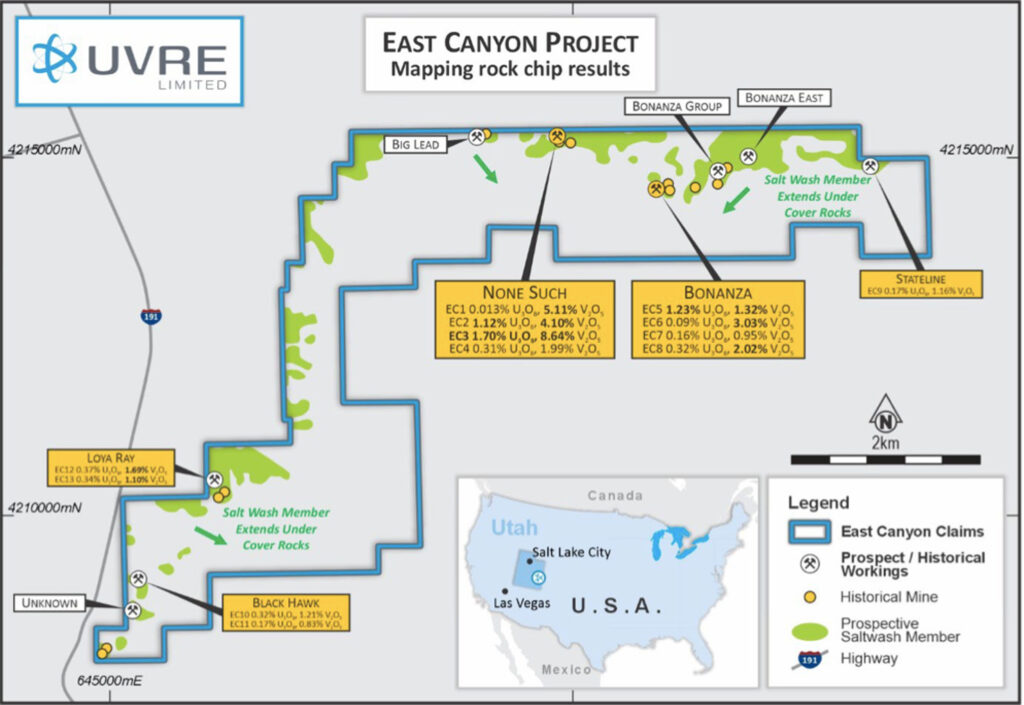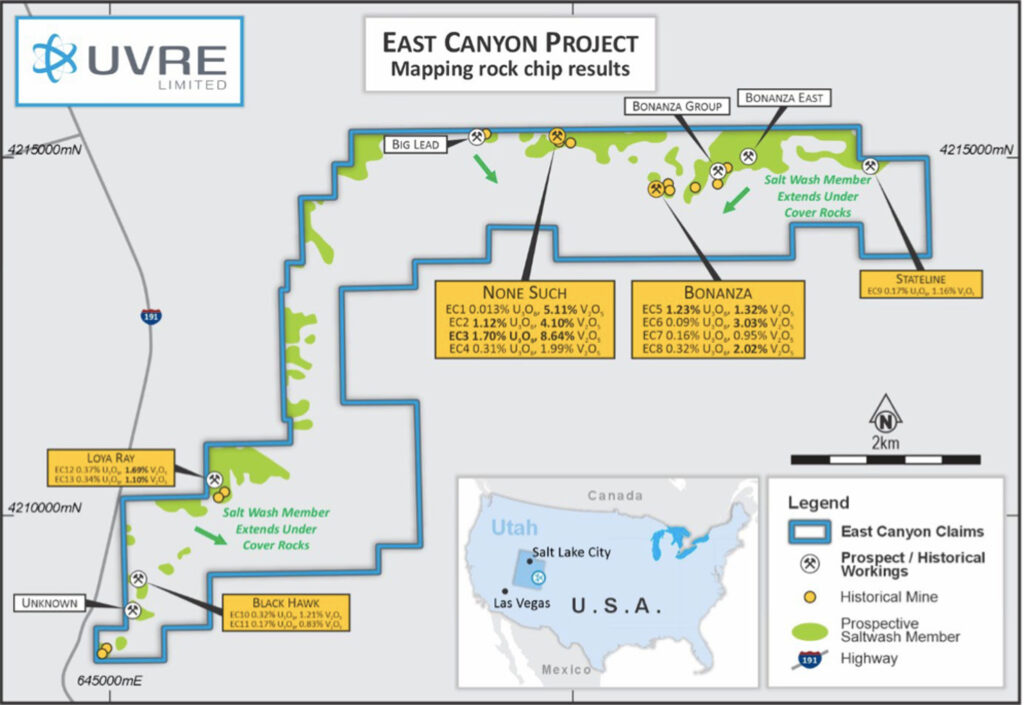Energy & Critical Metals
That’s high grade: Uvre confirms up to 1.7pc uranium, 8.64pc vanadium at US project
Special Report: Surface sampling at Uvre’s East Canyon project in Utah, USA, has confirmed high-grade results up to 1.70% uranium … Read More
The post…

- Rock chip samples returned high grade results at the East Canyon project
- Results up to 70% uranium and 8.64% vanadium were recorded
- The project is just 50km from Energy Fuels’ White Mesa Mill
Surface sampling at Uvre’s East Canyon project in Utah, USA, has confirmed high-grade results up to 1.70% uranium and 8.64% vanadium.
A field mapping and a scintillometer program (a device which measures radiation) flagged several locations with elevated counts per second (cps), indicating high levels of gamma radioactivity anomalous to background.
Rock chip samples were taken at these sites and returned consistent high-grade uranium and vanadium mineralization with U3O8% averaging 0.49% and V2O5 averaging 2.55% across the 13 samples collected.
Best rock chip sample results include sample EC3 returning 1.70 U3O8%, 8.64 V2O5%, sample EC2 returning 1.12 U3O8% and 4.10 V2O5% from the None Such prospect, and rock sample EC5 returning 1.23% U3O8% and 1.32 V2O5% from the Bonanza prospect.
Notably, Trace Rare-Earth Element Oxide (TREO) samples are included with anomalous samples received from the None Such prospect with sample EC 3 returning 1,753ppm TREO, at the Bonanza prospect with sample EC6 returning 615ppm TREO, at the Black Hawk prospect returning 324ppm TREO and at Loya Ray with 305ppm TREO.
The uranium mineral carnotite – rare uranium ore – was observed in rock specimens in the field and the results also confirm that uranium is consistent with the prior reported elevated handheld scintillometer readings, Uvre (ASX:UVA) says.
“[This] confirms the usefulness of this low-cost exploration device to detect uranium at surface in future field work,” the company said.
Anomalous rock chip samples were also returned from prospects Stateline, Black Hawk and Loya Ray with more field work required at these prospects.
Historic US production in the region
The East Canyon project comprises 231 contiguous claims prospective for both uranium and vanadium, two minerals anticipated to play a key role in the generation and storage of low-carbon energy.
It’s also smack bang in the Dry Valley/East Canyon mining district of south-eastern Utah, in the Uravan Mineral Belt where the surrounding Salt Wash ore producing districts of the Colorado Plateau have been an important source of uranium and vanadium in the US for more than 100 years.
Historic production amounts to more than 85 million pounds of uranium at an average grade of more than 0.13% U3O8 and more than 440 million pounds of vanadium at an average grade of 1.25% V2O5.
It’s no surprise that the district hosts several significant uranium-vanadium operations including TSX listed Energy Fuels’ La Sal Complex mines and development projects, Velvet-Wood, owned by TSX-V-listed company Anfield Resources, and International Consolidated Uranium’s Rim/Columbus and Sage Plains project – which was subject to a recent acquisition and strategic alliance with Energy Fuels.
Plus, Energy Fuels’ White Mesa Mill, is the only fully licensed and operating conventional uranium-vanadium mill in the US and is just 50km from the East Canyon project.

Defining priority exploration targets
Airborne magnetic and radiometric survey data across entire East Canyon project has also been received and is currently being processed and evaluated.
The radiometric survey is expected to assist to measure the indication of uranium by detecting gamma-rays produced during the natural radioactive decay of potassium, thorium and uranium within the top circa 30-45cm of surface lithology.
The magnetics will also help delineate potential deeper structural features which may influence and facilitate transportation of uranium mineralisation.
Essentially, any radiometric anomalism identified along inferred or mapped structures may include radon gas leakage along structures from uranium mineralization at depth.
Comparing the rock chip results with surface geology indicators as well as elevation stratigraphic influences relative to historical mines, scintillometer readings, rock chip sample results, historical mine workings and holes drilled at Bonanza and None Such prospects will help define priority exploration targets.
Uvre says the ongoing interpretation of all data with airborne survey results should be completed over the coming weeks.
This article was developed in collaboration with Uvre Limited, a Stockhead advertiser at the time of publishing.
This article does not constitute financial product advice. You should consider obtaining independent advice before making any financial decisions.
The post That’s high grade: Uvre confirms up to 1.7pc uranium, 8.64pc vanadium at US project appeared first on Stockhead.

Uranium Exploration Company Announces Additional Staking in the Athabasca Basin
Source: Streetwise Reports 12/22/2023
Skyharbour Resources Ltd. announced an update from its Canada-based Falcon Project along with additional…
Tesla Launches New Mega Factory Project In Shanghai, Designed To Manufacture 10,000 Megapacks Per Year
Tesla Launches New Mega Factory Project In Shanghai, Designed To Manufacture 10,000 Megapacks Per Year
Tesla has launched a new mega factory…
Giving thanks and taking stock after “a remarkable year”
An end-of-year thank you to our readers, industry colleagues and advertisers before Electric Autonomy breaks from publishing until Jan. 2
The post Giving…
















